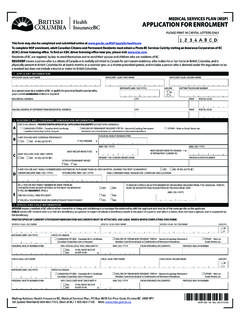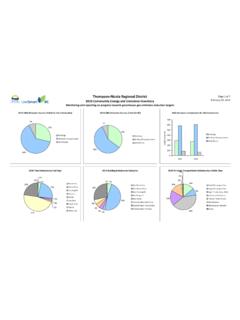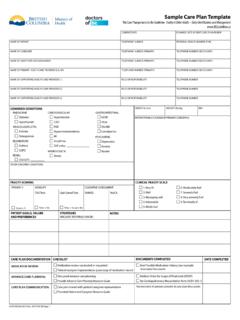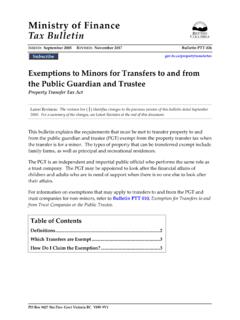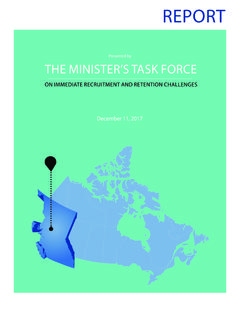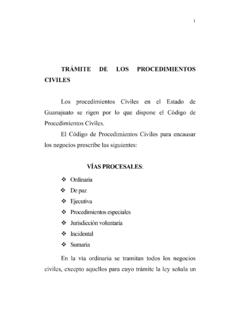Transcription of Beneficial Insects - Predators, Parasitoids and Pollinators
1 Beneficial Insects Predators, Parasitoids and Pollinators January, 2016 Beneficial Insects and mites belong to three categories: predators, Parasitoids , and Pollinators . Predators capture and eat other organisms such as Insects or mites. Predators include ladybird beetles, ground beetles, lacewings, syrphid (hover) flies, aphid midges (Aphidoletes) and yellowjacket wasps. Parasitoids are Insects that parasitize other Insects . The immature stages of Parasitoids develop on or within its host, eventually killing it. Parasitoids may attack all stages of their host (eggs, larvae, nymphs, pupae, adults). Pollinators include honeybees, leafcutter bees, other wild bees, butterflies, moths and other Insects that visit flowers to feed on nectar and pollen.
2 Pollinators transfer pollen in and between flowers of the same species (pollination) which is essential to seed and fruit production for plants. Common Predators and Parasitoids Ladybird beetles Appearance: There are many species of ladybird beetles that vary in size, colour and pattern. Depending on species, colours are black, red, orange-red to almost yellow. Most species have coloured spots or markings on their backs. Body length: Adult - ; Mature larva- Life Cycle: Overwinter as adults. Eggs (orange, elongated) are laid in clusters on underside of leaves and branches. Usually only one generation per year. Both the larvae and adults feed on pests.
3 Insect Pests Attacked: Aphids, whiteflies, scales, mites, mealybugs and other soft-bodied Insects . Monitoring: Inspect colonies of aphids for adults and/or larvae. Twospotted ladybird beetle adult feeding on aphid Multicolored Asian ladybird beetle adult Ladybird beetle eggs Ladybird beetle larvae Ladybird beetle pupae Lacewings Appearance: Common species of lacewings include two green lacewing species, Chrysoperla carnea and Chrysopa oculata, and one brown lacewing species, Hemerobius pacifus. Lacewing eggs are white and laid singly or in groups on long stalks on the underside of leaves or branches. The brown and green lacewing larvae are very similar except for small differences in body shape and the brown lacewing's habit of moving its head from side to side while walking.
4 Body length: Adult - mm; Mature larva - mm Life Cycle: Chrysoperla carnea and Hemerobius pacificus overwinter as adults; Chrysopa oculata as pupae. Up to four generations per year depending on temperature. Monitoring: Examine aphid- or psylla-infested leaves and shoots for feeding larvae or use limb taps. Insect Pests Attacked: Aphids, spider mites, whiteflies thrips, leafhoppers, scales, mealybugs, psyllids, small caterpillars and insect eggs. Green lacewing larvae feed on insect pests. Both larvae and adult brown lacewings feed on pests. Green lacewings are commercially available. Green lacewing adult Brown lacewing adult. Photo courtesy: Cropconsult Ltd.
5 Lacewing eggs Lacewing larva Syrphid (Hover) fly larvae Appearance: Hover fly larvae are flattened, legless maggots with no distinct head and a tapered body. They are variously coloured (yellow, green to brown). Adults frequent flowers over which they hover before landing to feed on nectar and pollen (their only food source). They are often mistaken for bees or wasps which they mimic in colouration. Hover fly eggs are white, elongate, with fine sculpturing and are visible in aphid colonies. Body length: Adult - mm; Mature larva - mm Life Cycle: Overwinter as larvae, pupae, or adults depending on the species. Eggs laid on aphid-infested plant parts.
6 Several generations per year depending on temperature and location. Insect Pests Attacked: Aphids, scales, thrips and other small soft-bodied Insects Monitoring: Examine aphid-infested leaves and shoots for maggot-like larvae. Adults frequent flowers. Syrphid fly larva feeding on aphid Syrphid fly adult Syrphid fly adult Syrphid fly pupa Praying mantids Appearance: Adults are 5-10 cm long and green, brown or yellow in colour. Mantids have an elongated thorax and grasping forelegs, which they use to hold their prey while they eat. Life cycle: One generation per year. Overwinters as eggs in egg cases, which are glued to wood, bark, or other plant material.
7 Insect Pests Attacked: Many, including aphids, flies, beetles. Feeds on pests as well as beneficials. Mantids grasp their prey with spined front legs and hold them while they eat. Praying mantis egg case Praying mantis adult Praying mantis adult Minute pirate bug (Anthocoris spp., Orius spp.) Appearance: Adult anthocorids have a narrow, pointed head, flattened, smooth body with distinctive clear markings on their back. Body length: Adult - mm; Mature nymph - mm Life Cycle: Overwinter as adults. Becomes active early in season. 3 to 4 generations per year. Insect Pests Attacked: Aphids, spider mites, thrips, psyllids, whiteflies and small caterpillars.
8 Monitoring: Limb taps in orchards will detect adults and nymphs. Adult anthocorid Three nymphal instars of the anthocorid, A. melanecerus Aphid midge (Aphidoletes spp.) Appearance: Adults of the predaceous midge Aphidoletes aphidimyza are tiny (3mm long), delicate, long-legged brown flies that are active at night and thus rarely seen. Body length: Adult - ; Mature nymph - Life Cycle: Overwinter as pupae in soil. Eggs are laid in colonies of aphids. Several generations per year. Insect Pests Attacked: Aphids Monitoring: Examine aphid colonies for presence of tiny orange maggot-like larvae or tiny paprika-like eggs. It may be necessary to inspect under aphids to find them.
9 Midge larva (Aphidoletes spp.) feeding on a winged aphid A. aphidimyza larva among aphid cast skins and killed aphids Bigeyed bug (Geocoris spp.) Appearance: Adults and nymphs are oval, somewhat flattened, about 4 mm long, usually brownish or yellowish, and have a wide head with large, bulging eyes. Life Cycle: 5 nymphal instars. Females lay oblong, pale-colored eggs singly on leaves which develop reddish eyespots shortly after being laid. Common on low-growing plants and crops. Insect Pests Attacked: Flea beetles, mites, insect eggs, small caterpillars, other bugs Bigeyed bug adult. Photo courtesy: Bradley Higbee, Paramount Farming, Predatory mites Appearance: The western predator mite, Typhlodromus occidentalis (Nesbitt), and Zetzellia mali are the two most common species of predaceous mites in They are distinguished from their prey by their larger size, pear-shaped body, and translucent colouration.
10 Their eggs are opaque and oval whereas pest mite eggs are round. They are very active and fast moving compared to pest mites. Body length: Adult - ; Mature nymph - Life Cycle: Overwinter as adults. Become active in spring and produce several generations per summer depending on temperature. Insect Pests Attacked: Spider mites, thrips, fungus gnat larvae Monitoring: Visual inspection of leaves or leaf brushing for microscopic examination. Predatory mite and 2-spotted spider mite Z. Mali feeding on European red mite egg Parasitic wasps Comments: Parasitic wasps occur in various shapes and sizes and are commonly named according to their family name (for example, ichneumons, brachnoids, chalcids, trichogramma).
